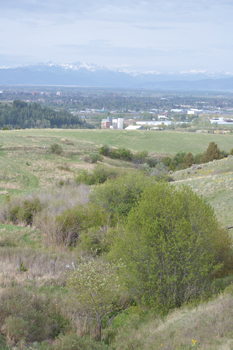A History of Bozeman’s Water System, Part I
Courtney Kramer | Friday May. 31st, 2013
 Modern communities develop on the skeleton of their infrastructure. The location and remaining capacity of water and sewer pipes, natural gas lines and electrical transmission capabilities often dictate the timing and intensity of growth. An understanding of the history of Bozeman’s water supply and distribution system is crucial to the preparation of an Integrated Water Resources Plan, currently under development by the City of Bozeman. The IWRP joins previous historic efforts to ensure sufficient supply of a crucial resource for our growing community.
Modern communities develop on the skeleton of their infrastructure. The location and remaining capacity of water and sewer pipes, natural gas lines and electrical transmission capabilities often dictate the timing and intensity of growth. An understanding of the history of Bozeman’s water supply and distribution system is crucial to the preparation of an Integrated Water Resources Plan, currently under development by the City of Bozeman. The IWRP joins previous historic efforts to ensure sufficient supply of a crucial resource for our growing community.
A history of Bozeman’s water works should be divided into two phases. This article focuses on the earlier development of Lyman Creek to the north of town and the initial construction of underground water pipes in the late 19th century. The July article will trace the acquisition of additional water resources from south of Bozeman and expansion of the original water delivery system in the first quarter of the 20th century.
After Bozeman’s founding in 1864, domestic water sources varied from public fountains, Bozeman Creek and wells on private property. Built in 1886, the Mendenhall house at 521 South Willson Avenue retains a small well house on the south side of the property.
The incorporation of the City of Bozeman in 1883 began the Civic Phase of our community’s development. During this era the primary function of a local government evolved into the protection of the public’s health, safety and welfare through the construction of public infrastructure.
Nineteenth century improvements in sanitation, especially sewer and water systems, greatly diminished the spread of water-borne illnesses like cholera, diphtheria and dysentery through contaminated water. Water pipes also provided for the public’s safety and welfare by making water available to suppress fires, always a danger in towns built primarily of wood.
Rather than publicly finance the water system, Bozeman’s City Council offered a partnership to the private sector. The City would give an investor the license to construct a distribution system under publicly owned property if the investor would provide the water source, install the pipes and bill consumers within an adopted rate structure. The agreement gave the City the option to purchase the system in 15 years.
After two previous public-private partnership attempts failed, the City Council adopted Ordinance 61 in August of 1888. The ordinance granted Walter Cooper, Robert Bernert, Sylvester Cary and Charles Robinson, under the name “Bozeman Water Works Company” the “license and privilege of establishing, maintaining and operating water works and of laying and maintaining water mains, pipes and fire hydrants in and along any and all of the streets, avenues, alleys and public grounds of the said City of Bozeman as they now exist or may hereafter be extended, and of selling water to the said City and to the inhabitants thereof.”
The ordinance specified Lyman’s Creek, north of town, as the main source of the water supply. The water rights were acquired from Nelson Story, who used some of the water to power his milling operation. The Water Works Company was required to lay not less than three miles of water pipes within the City Limits, which started at the intersection of Church and Fridley Streets, by September 1889.
The City agreed to adopt and enforce ordinances protecting the water system from damage as well as from the waste of water. Billing rates were also established, based on the type of use and intensity of use, as measured by number of sinks, bath tubs, and the domestic, commercial or industrial demand for water.
The large public works project attracted laborers. “Quite a number of laboring men have recently arrived in the city, in anticipation of employment as soon as ground is broken for the water works…” noted the Avant Courier newspaper on May 16, 1889. The Courier went on to note that the enterprise would employ one to two hundred extra hands during the summer.
A week later the Courier reported, “Bozeman has a resident who came into the city last week from St. Paul who had the courage to hang out his shingle as a plumber. There is nothing for him to do at present, but the completion of the water works plant will give him all he can attend to for the rest of this year, if not longer.”
The finished system moved water from the springs at Lyman Creek in wooden pipes under the East Gallatin River and into the City Limits. Sanborn Fire Insurance maps of the 1890’s denote the presence of four or six inch water lines in the streets beneath Bozeman.
Though the original ordinance specified a 15 year period to buy the water system, the City Council proposed municipal bonds for the acquisition three different times in the mid 1890’s. In October 1898, Bozeman voters approved $165,000 in bonds at 5% interest over 20 years by a narrow 28 vote majority. The bonds raised the funds necessary to purchase, extend and improve of the Bozeman Water Works Company. The Avant Courier noted, “If we could manage somehow to hold another election on the subject the proposition would probably be defeated.”
In March of 1899 the City Council adopted Ordinance 197, which related to the management of the Bozeman Water Works. The ordinance established a Water Committee to manage the operation and consumer billing associated with the water works, as well as specified how the City would fund extension of water mains.
In a nod to protection of the public’s health, in 1904 the City enacted Ordinance 354, which provided for the protection and the preservation of the purity of the water supply by establishing fines and jail time for people who tampered with the distribution system or polluted the water supply. Agricultural users in the Bridger foothills were put on notice that any pens, enclosures, stables or buildings for livestock that rendered the water supply impure would be deemed a nuisance and result in a minimum $5 fine.
The first phase of water system development came to a close in January 1906, when the City Council approved the sale of the excess lands surrounding the water works property in Lyman Canyon. The Council found that while the Lyman Creek water source sufficiently supplied the needs of the City the surrounding lands were more expensive to maintain than the rental income they provided.
Next month’s article will focus on how Bozeman’s healthy economy and building boom of the early 1900’s necessitated the development of water resources from the south of town.
Courtney Kramer is a proud graduate of MSU’s History Department and serves as the City of Bozeman’s Historic Preservation Officer. She may be contacted at the City Planning Office, 406-582-2260 or via email at ckramer@bozeman.net. More information about Bozeman’s historic districts is available at www.preservebozeman.org.
| Tweet |
